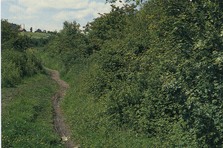

Biodiversity
Action
Plan
Hedgerows. Criss-crossing the landscape, marking historic field and parish boundaries, hedgerows are a key habitat for many species of conservation concern. Wildlife uses hedgerows for foraging, feeding, breeding, shelter and a refuge from predators.
Hedgerows often support a rich flora at their base, support invertebrates such as butterflies and moths, and act as wildlife corridors for many species, allowing movement between habitats.
Priority habitat details
Hedgerow priority habitat —lines of bushes, shrubs and sometimes trees— has to be over 20m long and up to 5m wide, with no gaps more than 20m.
Hedgerows are part of the Boundary and Linear Features broad habitat type which also includes lines of trees, walls, stone and earth banks, grass strips and dry ditches.
The first UKBAP definition of the priority habitat was for Ancient or Species-rich hedgerows*, the latter with least four native tree or shrub species or a rich basal flora of herbaceous plants.
The UK BAP (2007) widened it to include all hedges with 80% or more of at least one native tree or shrub species.
Banks or ditches associated with hedgerows are part of the habitat, as well as vegetation in hedgerow banks.
Hedgerow is a local priority habitat because of its national status, the species it supports and the potential for its conservation in Barnsley.
The Hedgerow priority habitat UKHab category is h2a. Other hedgerows are h2b.
*Phase 1 habitat surveys have a different definition of ‘species-rich hedges’: hedges with native shrub/tree species and a relatively high plant species-richness, and mostly undisturbed bottom flora.
The term defunct hedgerow in Phase 1 surveys refers to gappy and no longer stock-proof hedges. They can still be valuable for biodiversity.
The best hedgerows in Barnsley for biodiversity are ancient and/or ‘species-rich’ hedgerows. These hedgerows will consist of several tree or shrub species, may contain veteran trees and deadwood, and may possibly have a rich basal flora of herbaceous plants. In some cases they may be remnants of ancient woodland.
Ancient hedgerows will have been in existence from before the Enclosures from 1750 to 1860. The thin straight Hawthorn hedges of the Enclosures support less biodiversity, as do hedges of Beech, Privet, Yew or non-native trees.
The UK BAP (2007) recognised all hedges with 80% or more of at least one native tree or shrub species as UK BAP priority habitat.
21 important hedgerows have been identified in Barnsley: 13 species-rich old lanes, six species-rich hedgerows and two hedgerow banks. Only one, Black Lane, currently has LWS status as a hedgerow. More on sites
In the Barnsley area hedgerows still act as wildlife corridors for many species including bats. They are particularly important for moths and butterflies such as White-letter Hairstreak, and farmland birds including Grey Partridge, Linnet and Yellowhammer. More on species and features
Gappy hedgerows and tree lines, whilst not priority habitat, have a value for wildlife - as do walls and other boundary features.
Please use the following links for more information on hedgerows.


Hedgerow
